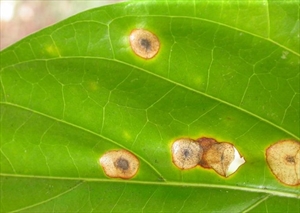- Narrow distribution. Probably, a fungal disease of minor importance. Lack of research on control measures.
- Spots roughly circular, up to 2 cm diameter, yellowish, grey or reddish brown with narrow red borders, and black fruiting bodies within. Centres of spots may fall out.
- Spread occurs by rain splash or spores carried by wind.
- Cultural control: plant at wider than normal spacing; collect and burn infected leaves; do not shade, i.e., grow beneath tall trees.
- Chemical control: use copper, chlorothalonil or mancozeb.
Pacific Pests, Pathogens, Weeds & Pesticides - Online edition
Pacific Pests, Pathogens, Weeds & Pesticides
Noni shot-hole disease (313)
Noni shot-hole disease, noni frog-eye
Guignardia morindae; this is the sexual state. and Phyllosticta morindae is the asexual state, i.e., spores are produced without mating types combining. Other names previously used are Phyllostictina morindae and Physalospora morindae.
AUTHORS Grahame Jackson & Eric McKenzie
Photos 1-4 (taken by Eric McKenzie), and used in this fact sheet, appeared previously in McKenzie E (2013) Guignardia morindae PaDIL - (http://www.padil.gov.au); and from Noni shot hole (2006) College of Tropical Agriculture and Human Resources, University of Hawai'i at Manoa. (https://www.ctahr.hawaii.edu/noni/shot_hole.asp#:~:text=Pathogen%3A%20Noni%20shot%20hole%20is,specks%20on%20leaves%20and%20bracts.).
Produced with support from the Australian Centre for International Agricultural Research under project PC/2010/090: Strengthening integrated crop management research in the Pacific Islands in support of sustainable intensification of high-value crop production, implemented by the University of Queensland and the Secretariat of the Pacific Community.







